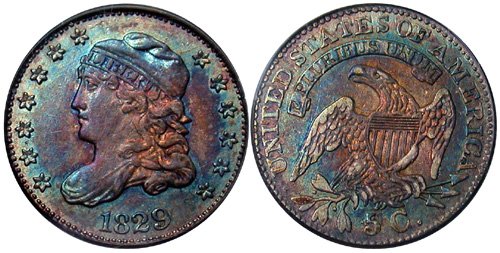Guide to U.S. Capped Bust Half Dimes
The half dime denomination was not struck by the United States Mint from 1806 to 1828. During this time, circulation of virtually all federal coinage was sparse, and half dimes were of such small intrinsic value that they were not used for export. The need for minor silver coinage was mostly fulfilled by foreign coins, most notably from Mexico and South American countries. On July 4, 1829, coinage of the Capped Bust Half Dime commenced, coinciding with the opening of the second Philadelphia Mint. The new series of half dimes would be produced in reasonably significant quantities from 1829 to 1837, making all dates relatively available.

By the time the Capped Bust Half Dime was introduced, all United States silver coins featured the same basic design. The design had been introduced on the half dollar in 1807, followed by the dime in 1809, and the quarter dollar in 1815. While the design on these denominations varied slightly, each was based on the work of John Reich with modifications made by William Kneass at a later date.
The obverse of the half dime features the head of Liberty, facing left. She wears a Phrygian cap inscribed LIBERTY with long, curling hair beneath. A gown secured by a brooch is draped across the truncation of her neck. The date, slightly curved, appears directly beneath and comes in various sizes. There are seven stars are before Liberty and six stars behind, for a total of thirteen to represent the original states of the Union.
The reverse features an eagle with its wings spread and a shield placed at its breast. The eagle’s talons grasp an olive branch and a bundle of arrows. The denomination, which appears for the first time on these small silver coins, is found below as “5 C.” A scroll placed directly above the eagle carries the motto E PLURIBUS UNUM, and UNITED STATES OF AMERICA appears surrounding.

